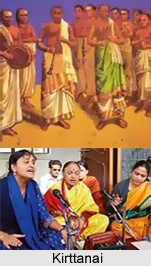 Kirttanai is a Tamil form of kirtan. Since the thirteenth century, Tamil culture faced extensive artistic and linguistic influences from other parts of India. Their impact was obvious in theatre as well. The significant two-way transactions between Telugu and Tamil resulted in Kirttanai.
Kirttanai is a Tamil form of kirtan. Since the thirteenth century, Tamil culture faced extensive artistic and linguistic influences from other parts of India. Their impact was obvious in theatre as well. The significant two-way transactions between Telugu and Tamil resulted in Kirttanai.
Kirttanai is mainly rendering a story through musical narration. This is different from ballade ring traditions in its dramatic aspects. The first part involves invocation and kappu i.e. prayer, as in the case of most written forms. The mid-section relates the tale and the last section concludes it. Among the most famous composers, Arunachala Kavirayar during 1711-88 abridged the whole Ramayana into Rama nataka kirttanai i.e. `Kirttanai of Rama`s Drama`, and Gopalakrishna Bharati during 1810-81 used Hindustani, Carnatic, and folk melodies in Nandanar charittira kirttanai i.e. `Kirttanai of Nandan`s Life`. Various groups at the end of the nineteenth and beginning of the twentieth centuries staged this. The latter became a favourite source for films as well, starring such popular singers as Sundarambal. Interestingly, the gods praised in Kirttanai are mostly worshipped by the upper strata of society. Very few folk deities find a place in this form.
Kirttanai is written in the sindu poetic tradition. This is closely related to folk music. It can thus illustrate how folk forms merged into evolving Carnatic classical music. It is also an important resource to study the link between Carnatic music and Tamil theatre. Its major songs are called viruttam, taru, and tibatai. Taru, in particular, contains all the elements of theatre. Kirttanai also employs katka, tandaham, nondi sindu, lavani, kannigal, kummi, tukkada, esal, ananda kalippu, agaval, and javali varieties of song.
This article is a stub. You can enrich by adding more information to it. Send your Write Up to content@indianetzone.com




